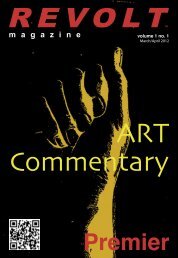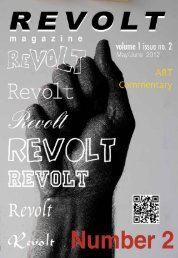Download PDF Version Revolt Magazine, Volume 1 Issue No.4
Download PDF Version Revolt Magazine, Volume 1 Issue No.4
Download PDF Version Revolt Magazine, Volume 1 Issue No.4
You also want an ePaper? Increase the reach of your titles
YUMPU automatically turns print PDFs into web optimized ePapers that Google loves.
artist, “Father of MTV,” conceptual prankster and<br />
founder of the Rat Bastard Protective Association,<br />
a group of Beat and Funk artists, felt that “This<br />
final form was not ever finished, it had to take<br />
an uncontrolled event to make it stop.” Conner<br />
documented this “transplant” in his 7 minute<br />
film, The White Rose (1967) Jay DeFeo’s Painting<br />
Removed by Angelic Hosts (1967), to the sounds of<br />
Miles Davis’s Sketches of Spain.<br />
DeFeo stopped refining it three months later.<br />
Renamed from Deathrose which she thought “just<br />
a little melodramatic,” now to The White Rose,<br />
feeling “ the rose was so much an aspect of life as<br />
of death,” she eventually just went with The Rose,<br />
“the unity with both of those opposite ideas.”<br />
The Rose had its first public showing in 1969 at<br />
the Pasadena Art Museum, traveled to the San<br />
Francisco Museum of Art and was afterwards<br />
installed in the new wing at the San Francisco Art<br />
Institute, where it was bolted to a concrete wall in<br />
the McMillan Conference Room.<br />
“I had done absolutely nothing from the time I<br />
finished The Rose until 1970. I was repairing<br />
my personal life as well as my psyche after the<br />
heavy experience that the painting of The Rose<br />
was. I needed that time to restore some kind of<br />
equilibrium and gain some kind of perspective on<br />
my life’s work and get some feeling of what could<br />
naturally come after that.”<br />
With the emergence of Minimalist and Pop Art<br />
during the ‘60s, not seeing herself as part of the<br />
feminist movement and maybe being too tightly<br />
pegged as a “Beat” artist, DeFeo began feeling as<br />
if the art world had moved on and was showing<br />
little interest in her work. She bought a Hasselblad<br />
camera and immersed herself into photography.<br />
She continued to seek museum placement for<br />
The Rose. By 1972, it was showing signs of<br />
hair line cracks, nicotine grime, scratch marks,<br />
graffiti, coffee stains, loose chunks of paint, with<br />
the canvas sagging from its weight. DeFeo knew<br />
she’d have to find help to cover these now needed<br />
repairs. Conner screened his film, which had<br />
already helped to keep The Rose in the public eye,<br />
for grassroot fundraising campaigns. Events were<br />
organized. DeFeo received a $1,500 National<br />
Endowment grant. News about the The Rose<br />
resurfaced in the San Francisco press as they<br />
covered the story of DeFeo’s restoration efforts.<br />
The museum conservation team started to clean<br />
and repair The Rose, encasing it in a structure<br />
of wax, starch paste, polyvinyl acetate, packing<br />
material, mulberry tissue, cotton sheeting and<br />
plaster reinforced with chicken wire. Money ran<br />
out. A particle board wall was eventually built<br />
in front of it for student exhibitions. The Rose<br />
remained hidden for the next twenty years.<br />
As the art world “rediscovered” DeFeo, her new<br />
work began to see momentum by 1975 with a run<br />
of successful one-person shows that followed.<br />
Curatorial consultant Leah Levy joined her efforts<br />
The Rose, 1958–66, Oil with wood and mica on canvas, 128 7/8 x 92 1/4 x 11 in. (327.3 x 234.3<br />
x 27.9 cm). Whitney Museum of American Art, New York; gift of The Jay DeFeo Trust, Berkeley, CA, and purchase with funds<br />
from the Contemporary Painting and Sculpture Committee and the Judith Rothschild Foundation 95.170, © 2012 The Jay<br />
DeFeo Trust / Artists Rights Society (ARS), New York, Photograph by Ben Blackwell.<br />
to find a permanent home for The Rose. DeFeo<br />
took a teaching position at Mills College and<br />
climbed Mount Kenya, a lifelong dream.<br />
The Rose continued to remain an obscure mystery.<br />
After DeFeo’s death in 1989, The Jay DeFeo Trust<br />
was established and the search for a permanent<br />
location for The Rose continued. Would a museum<br />
take the risk of putting out money, not knowing<br />
if the painting was salvageable or not? DeFeo’s<br />
patrons and the “Friends of the Rose” were<br />
committed and determined. They felt deeply<br />
captivated and transformed by The Rose. They<br />
praised her as a true innovator. Her struggle had<br />
now become their own struggle to bring The Rose<br />
back to life.<br />
In 1992, Lisa Phillips, the Whitney Museum’s<br />
curator, contacted the estate about a possible loan<br />
of The Rose for their upcoming exhibition, Beat<br />
obviously in no condition to be shown. The estate<br />
contacted Lisa Lyons at the Lannan Foundation<br />
in Los Angeles for possible conservation support.<br />
J. Patrick Lannan had been an avid collector of<br />
DeFeo’s work and had originally wanted to buy the<br />
unfinished Deathrose, which he had nicknamed<br />
“The Endless Road.” Three small square windows<br />
were cut into the plaster covering, and, to<br />
everyone’s surprise, it hadn’t turned into “slime”<br />
or “goo” or become coated with mold. Two years<br />
later, the Lannan Foundation redirected its mission<br />
away from the acquisition of art.<br />
David Ross, director of the Whitney, told Levy,<br />
“It’s one of the greatest masterpieces of postwar<br />
American art. It had to be rescued.” The Whitney





